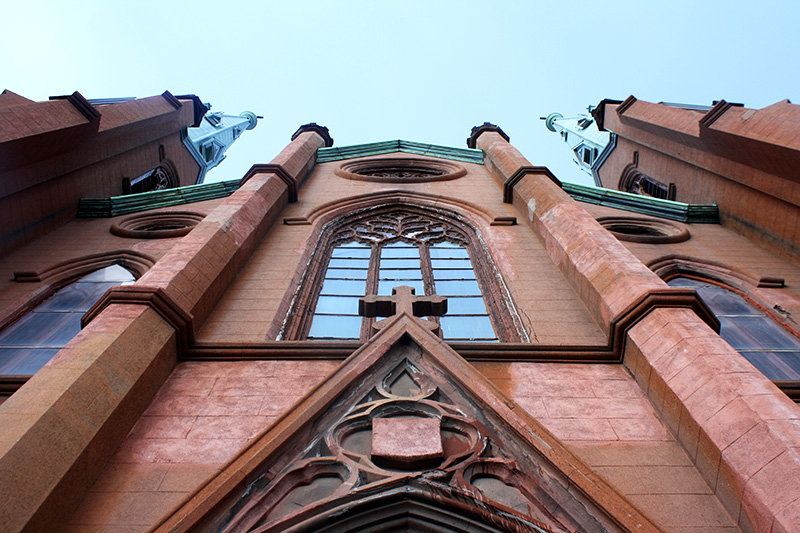Commonwealth Court to rule on Church of the Assumption

Timeline
Mar. 2006: Siloam purchases Church of the Assumption and three attached properties from the Archdiocese of Philadelphia for $800,000.
May 2009: Historical Commission adds Church of the Assumption to the historic register.
July 2009: L&I cites the property for being “deteriorated and in danger of collapse,” and instructs the owner to repair or demolish the property.
Aug. 2010: Siloam applies for a permit to demolish the church.
Sep. 2010: Historical Commission finds hardship approves demolition permit. Callowhill Neighborhood Association (CNA) appeals the Commission’s decision to the Board of L&I Review (BLIR).
May 2011: Board of L&I Review overturns Historical Commission, agreeing with CNA that the property was not marketed for enough time and that not all reuse possibilities were exhausted. Siloam appeals BLIR decision to Court of Common Pleas.
May 2012: Lawyers for CNA and Siloam argue before Court of Common Pleas.
July 2012: Siloam sells Church of the Assumption and related properties to Chinatown developer John Wei, for $1.12 million.
Oct. 2012: Judge Idee C. Fox reverses BLIR decision and affirms Historical Commission’s original finding of hardship. CNA appeals Judge Fox’s decision to Commonwealth Court.
Nov. 2012: John Wei pulls demolition permits for Church of the Assumption.
Dec. 2012: BLIR issues a temporary stay of demolition and asks Historical Commission for opinion.
Jan. 2013: Historical Commission unanimously votes that its original hardship finding was justified, and therefore the demolition permit was issued properly.
Feb. 2013: BLIR votes to uphold the stay of demolition pending Commonwealth Court review.
Oct. 2013: CNA and Historical Commission attorneys argue before Commonwealth Court.
Last week, attorneys for the City and for Callowhill Neighborhood Association made arguments before a panel of Commonwealth Court judges in the ongoing battle over the Church of the Assumption, a Catholic Church building at 12th and Spring Garden streets that was constructed in the 1850s and placed on the city’s historic register in 2009.
In 2010, the Philadelphia Historical Commission granted permission to demolish to the building’s owner, Siloam, a nonprofit group that serves people affected by HIV/AIDS. Since then, the case has been appealed to the Board of L&I Review, the Court of Common Pleas, and the Commonwealth Court.
The attorneys, Sam Stretton for CNA and Andrew Ross representing the Historical Commission, were given 7-½ minutes each to argue before Commonwealth Court on Thursday morning, plus some back and forth with the judges, according to Andy Palewski, who wrote the church’s nomination for historic certification. The Court’s decision could come down any time in the next one to six months, said Andy Ross.
The case now involves a few major legal questions. Most importantly to Commonwealth Court, did Common Pleas Judge Idee C. Fox properly reverse the Board of L&I Review’s decision to overturn the Historical Commission and affirm hardship for the property, which by the time of her decision had been sold to developer John Wei?
In briefs filed to the Court, Andy Ross says “yes,” and Sam Stretton says “no.”
Stretton’s argument on behalf of CNA is that the decision of the Board of L&I Review was based on “substantial evidence,” and that of the Historical Commission, which does not employ a court reporter to keep a full record of its meetings, was not. Court precedent holding that the Historical Commission should be given deference in interpreting the preservation ordinance is not applicable to this case, Stretton says.
In the court brief, Stretton reiterated CNA’s argument that the hardship finding for the Church of the Assumption was not justified. Stretton’s argument is based on a few main points:
-
When attempting to sell the property, Siloam never lowered the asking price from $575,000.
-
Siloam asked potential buyers to prove they had financing to make repairs, which Stretton said is comparable to raising the asking price for the Church.
-
Siloam gutted the interior of the church, reducing the value of the property. Stretton called this a “self-imposed hardship.”
-
The property was only marketed for five to six months, even though comparable properties can take up to two years to sell.
-
At least one potential buyer testified to the Board of L&I Review.
-
“Substantial tax credits” were available to Siloam to make repairs to the property.
Stretton’s conclusion is that the owners did not make a “good faith” attempt to market or reuse the propetry, as required in the Historic Preservation Ordinance.
In his own brief, Andy Ross counters that CNA’s argument merely “criticizes” Siloam’s efforts without “contradicting” the evidence that the group did, in fact, make substantial efforts to sell the property.
“Both in the Opinion [of Judge Fox] and in the record, it is clear that most of the testimony on behalf of CNA took whatever the Owner had done and claimed it was not enough,” Ross wrote. “Set an asking price on the Property? Make it lower. Offer it for sale? Do it longer. Employ an established real estate firm with a track record in institutional properties? Put it on Craigslist.”
Ross asks the Commonwealth Court to affirm Judge Fox’s opinion and, in effect, the original decision of the Historical Commission.
Another question that the Court will consider is whether the hardship finding “runs with the land” or is attached instead to the owner. In issuing the demolition permit to the new owner without a new hearing, the Historical Commission essentially affirmed that the hardship goes with the property. Stretton and CNA argue that the fact of the building’s sale from Siloam to John Wei is proof that there is no hardship for the property.
WHYY is your source for fact-based, in-depth journalism and information. As a nonprofit organization, we rely on financial support from readers like you. Please give today.



